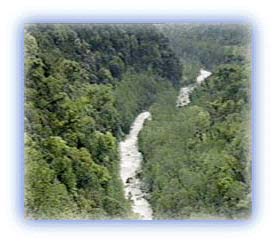Environmental Problems
General Info
Man-made problems
· Overgrazing
· Fires
· Quarrying
· Landslides
· Mountaineering
· Trekking
· Road construction
Natural Processes
· Earthquakes
· Glaciers
· Avalanches
· River and stream erosion

![]()
| Forest degradation The Himalayas are known for their tremendous biodiversity. The variety of vegetation found in the region, from tropical rainforests to alpine and sub-alpine forests, is truly breathtaking. However, due to the growing human population, forests are being affected in many ways. Forest lands are being cut down rapidly in many areas to provide new locations for human habitation. |
 |
| Rainforests of the Eastern Himalayas Credit: Karamjeet Singh |
Moreover, the rising human population has resulted in a dramatic increase in the demand for a variety of resources. Many of these resources come from forest based industries, which depend on the Himalayan forests, along with other forests, for their raw materials. For this reason, forests are being cut down unscrupulously in many areas. Tropical forests provide timber. Forests in the middle altitudes are also cut as the wood serves a variety of purposes. In higher altitudes, coniferous forests are felled to obtain softwood, which is used for making furniture, sports goods and newsprint.
In addition, forests are still used in many areas for providing firewood to the villagers. In fact, almost the entire energy needs of these areas are met from fuelwood obtained from the felling of trees growing in the forests and near the agricultural field. Moreover, the trees and shrubs are used as fodder for the domestic animals reared by the mountain people. In some areas, the age-old practise of shifting cultivation still exists. Here, a patch of forest land is burnt and cleared. The land is intensely cultivated for the next few years, until it loses fertility. Then, the land is abandoned, and a new patch of forest land is cleared. Earlier, the forests would rapidly grow back in the area that had been cleared. But today, the extraordinary demands put on the forest lands mean that these forests no longer stand the chance of growing back in the cleared areas.
 |
| In the valleys tall trees compete for sunlight. Credit: Debangsu Sengupta |
This problem is particularly severe in the cold desert regions. Nature has not bestowed these regions with a rich vegetative cover primarily due to the harsh environmental conditions like the severe cold, short growing season, high altitude and fragile soil. However, the little forests that these regions have are also used for many purposes. The result -- lands that were once thickly forested today stand devoid of any vegetative cover.
Over the past several decades, the ever increasing population and decreasing vegetative cover has brought an unprecedented pressure on the trees and forests that remain. Standing trees were felled for fuelwood wherever available, and when these too became scarce, people uprooted the stumps of old trees and took them away for burning in the rural hearths.
Today, forests have reduced drastically or completely vanished from many parts of the Himalayas. People in their eighties or seventies recollect that there once stood forests where now lie barren wastelands, capable of supporting only a meagre growth of grass.
Forest degradation also leads to a variety of other problems, including soil erosion and landslides.
All rights reserved